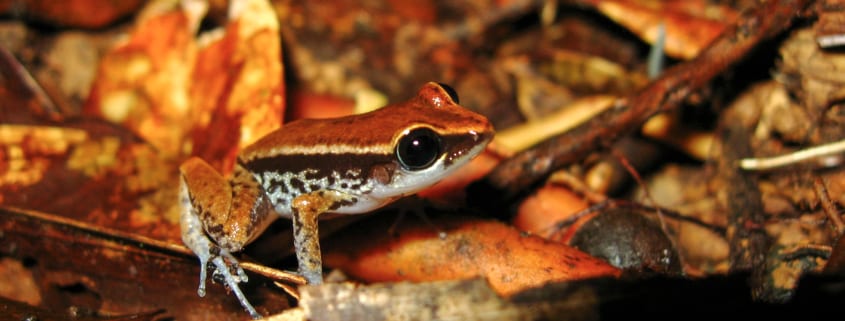Amphibians and Trees Further Protected in Puerto Rico
The Sierra de Cayey, in the southeast corner of Puerto Rico’s Central Mountain Range, houses some of the island’s most important ecosystems. The site is crucial to Puerto Rico’s endemic amphibians and plants, as well as local birds. But expanding agricultural development threatens to destroy the region’s forests. The growing specter of climate change could also upend these fragile, climate-dependent ecosystems.
In light of these threats, Rainforest Trust and local partner Para la Naturaleza (PLN) have worked to protect these forests. And this summer, the two organizations purchased 112 acres of critical habitat in the area. The acquired property sits next to the Carite State Forest and expands the Ulpiano Casal Natural Protected Area, helping to grow this vital network of protected areas.

The Sierra de Cayey. Photo courtesy of Para la Naturaleza.
The Sierra de Cayey is home to 15 of Puerto Rico’s 18 endemic amphibian species. Amphibians like these often require precise microhabitats with specific climates to survive. But as development continues and the climate crisis upends ecosystems around the world, these microhabitats disappear. Protecting large tracts of forest is necessary to buffer the worst effects of climate change on amphibians.
These threats haven’t spared the secluded island amphibian populations of Puerto Rico. In fact, three of the area’s endemic species, the Villalba Robber Frog, Karl’s Robber Frog and Eleutherodactylus jasperi, are already likely extinct. The International Union for Conservation of Nature lists all three as Critically Endangered, but scientists have not observed any of these species in at least 30 years. By expanding the reserve network, this new purchase reduces habitat fragmentation and prevents development. This protection will help reduce the cumulative impact of climate change and fragmented habitat for amphibians and other wildlife in Sierra de Cayey.

Eleutherodactylus wightmanae, an Endangered frog native to Puerto Rico. Photo courtesy of Para la Naturaleza.
But amphibians aren’t the only species to benefit from this new protection. The area is a Key Biodiversity Area and has some of the highest tree species diversity and endemism in Puerto Rico. Resident species include communities of ferns and lycophytes, as well as the Critically Endangered Palo de Jazmin, one of Puerto Rico’s rarest endemic trees. Human communities will also benefit from this protection, since these forests contain the headwaters of the Río Grande de Loíza, which provides water to over half of the people living in Puerto Rico’s capital.
Para la Naturaleza, who already protects 33,000 acres across the island, will integrate this property into the Ulpiano Casal Natural Protected Area and develop a management plan. Immediate management steps include marking boundaries, inventorying biodiversity and restoring degraded habitat.
“Expanding protections in Sierra de Cayey is vital to the future of Puerto Rico’s biodiversity,” said Angela Yang, Rainforest Trust’s Chief Conservation Officer. “Only through safeguarding these forests for wildlife and people can we secure a sustainable future for the island.”
Header photo courtesy of Para la Naturaleza.
This project was made possible through the generous support of our partner, Para la Naturaleza, donors to this project and the Conservation Action Fund, and the SAVES Challenge.






